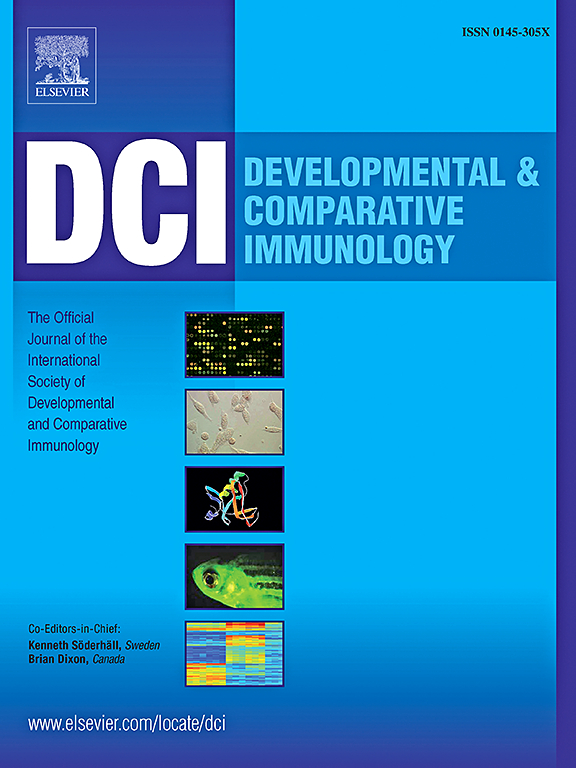The essential function of cathepsin X of the orange-spotted grouper, Epinephelus coioides during SGIV infection
IF 2.7
3区 农林科学
Q1 FISHERIES
引用次数: 0
Abstract
Cathepsin X, a class of cysteine proteases in the lysosome, involved in intracellular protein degradation processes. Numerous reports revealed that many kinds of cysteine proteases played a crucial role in pathogen invasion. To investigate the relationship between cathepsin X of teleost fish and virus infection, EcCX was cloned and characterized in the orange-spotted grouper, Epinephelus coioides. The open reading frame (ORF) of EcCX included 909 nucleotides and encoded a protein consisting of 302 amino acids, which shared 75% and 56% identity with zebrafish and humans, respectively. The protein EcCX mainly consisted of a signal peptide (1–19 aa), a pro-pre-peptide region (20–55 aa), and a mature cysteine protease region (56–302 aa). Subcellular localization analysis showed that EcCX was mainly distributed in the cytoplasm, but EcCX ectoped to the vicinity of apoptotic vesicles in FHM cells during SGIV infection. Following stimulation with SGIV or Poly (dA:dT), there was a notable rise in the expression levels of EcCX. EcCX overexpression facilitated virus infection, upregulated the production of inflammatory factors, and induced the activation of the NF-κB promoter. Furthermore, the overexpression of EcCX also accelerated the process of SGIV-induced apoptosis, potentially by enhancing the promoter activity of P53 and AP-1. Overall, our findings demonstrated a correlation between the function of EcCX and SGIV infection, providing a new understanding of the mechanisms involved in fish virus infection.
橙斑石斑鱼的螯蛋白 X 在 SGIV 感染过程中的重要功能
凝血酶 X 是溶酶体中的一类半胱氨酸蛋白酶,参与细胞内蛋白质的降解过程。大量报道表明,多种半胱氨酸蛋白酶在病原体入侵中发挥着重要作用。为了研究远洋鱼类的螯蛋白 X 与病毒感染之间的关系,我们克隆了橙斑石斑鱼的 EcCX,并对其进行了表征。EcCX的开放阅读框(ORF)包括909个核苷酸,编码由302个氨基酸组成的蛋白质,与斑马鱼和人类的相同度分别为75%和56%。蛋白 EcCX 主要由信号肽(1-19 aa)、前肽区(20-55 aa)和成熟半胱氨酸蛋白酶区(56-302 aa)组成。亚细胞定位分析表明,ECCX主要分布在细胞质中,但在SGIV感染FHM细胞时,ECCX会异位到凋亡小泡附近。在受到 SGIV 或 Poly (dA:dT) 刺激后,EcCX 的表达水平明显上升。EcCX 的过表达促进了病毒感染,上调了炎症因子的产生,并诱导了 NF-κB 启动子的激活。此外,过表达 EcCX 还可能通过增强 P53 和 AP-1 的启动子活性,加速了 SGIV 诱导的细胞凋亡过程。总之,我们的研究结果表明了 EcCX 的功能与 SGIV 感染之间的相关性,为鱼类病毒感染的相关机制提供了新的认识。
本文章由计算机程序翻译,如有差异,请以英文原文为准。
求助全文
约1分钟内获得全文
求助全文
来源期刊
CiteScore
6.20
自引率
6.90%
发文量
206
审稿时长
49 days
期刊介绍:
Developmental and Comparative Immunology (DCI) is an international journal that publishes articles describing original research in all areas of immunology, including comparative aspects of immunity and the evolution and development of the immune system. Manuscripts describing studies of immune systems in both vertebrates and invertebrates are welcome. All levels of immunological investigations are appropriate: organismal, cellular, biochemical and molecular genetics, extending to such fields as aging of the immune system, interaction between the immune and neuroendocrine system and intestinal immunity.

 求助内容:
求助内容: 应助结果提醒方式:
应助结果提醒方式:


